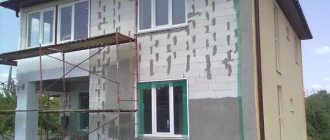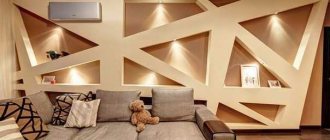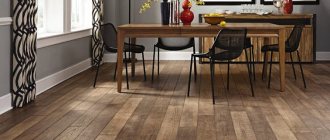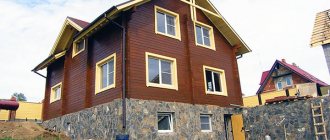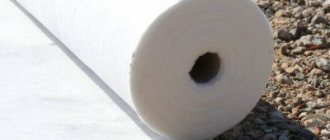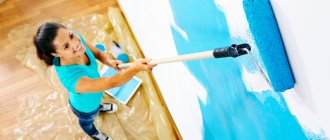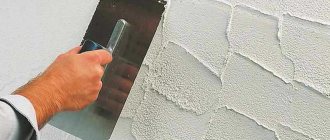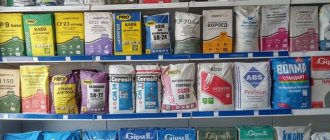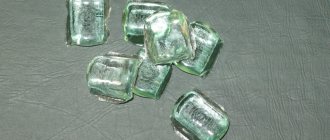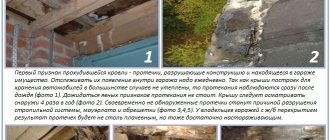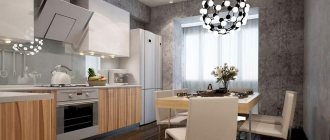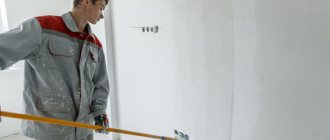| Place | Name | Characteristics in the rating |
| TOP 10 best facade plasters |
| Farbe | Premium quality facade plaster | |
| 1 | Ceresit CT 29 | The best manufacturer of plaster mixtures |
| 2 | Perel TeploRob | High level of thermal insulation |
| 3 | Dufa STRUKTUR PUTZ | The highest quality coating |
| 4 | EcoStone Bayramix | The best plaster with natural stone |
| 5 | Founds TC117 | Universal mixture for mineral surfaces |
| 6 | Perel Silicio | Ready-made silicone mixture |
| 7 | TICIANA | The best basement plaster |
| 8 | PEREL Termix 0319 | Reinforced coating |
| 9 | CenterPro SR-65 | Waterproofing coating |
| 10 | KREPS Thermocreps | Cement plaster with texture |
Heat and sound insulation
Any facade plaster allows you to retain heat and protects from unnecessary noise. There are also special heat-insulating mixtures, which include perlite and foam glass. Thanks to them, the plaster further improves thermal conductivity. This finish does not allow moisture to pass through, but interacts with air, so the plaster does not become heavier and fungus does not appear under it. If the walls in a building are very thin and require additional insulation, you can use the “wet insulation” method. Its essence lies in the fact that foam plastic sheets are glued to the facade. Afterwards the plaster is applied.
Cladding the façade with plaster can reduce the level of sound reaching the interior of the room. This is especially important if the building is located in a noisy area. In addition to the main components, such a solution should include pumice or slag. The porosity of their structure absorbs noise to some extent, muffling the sound. To improve the sound insulation of your home, you can use mineral wool or foam boards.
Types of modern facade plasters
Facade plasters are divided into two types:
- Repair plasters . They are used as a basis for applying decorative plaster, as well as leveling walls;
- Decorative plasters . Using them you can create a unique relief or pattern on the walls. As a rule, they contain a protective layer and special pigments to achieve the desired wall color.
In turn, these types are further subdivided according to the composition of the mixtures and texture.
Now they produce four types of facade plaster according to their composition: mineral, silicate, acrylic, silicone. All of them differ from each other not only in their composition and properties, but also in the features of working with them. Let's look at this point in more detail.
Mineral facade plaster
Most often it is called cement. It is the most popular among developers because it is inexpensive, yet it is very strong and easy to apply.
Mineral facade plaster is a dry mixture of cement and various additives. It has properties such as strength, vapor permeability, and water absorption. She even independently fights the appearance of fungus and mold on the walls.
Its main disadvantage is low elasticity; when the building shrinks or vibrates, this leads to the formation of cracks and microcracks on the walls. In addition, mineral plaster gets dirty quickly and is limited in color range. Although this can be easily corrected with silicate paint, which is inexpensive and adheres well to cement. It does not reduce vapor permeability and strengthens the surface.
Silicate facade plaster
It is also mineral, but it also contains liquid glass.
Silicate plaster allows steam to pass through very well, it is elastic and repels dust. Plastering with such mixtures is easy. However, due to its high vapor permeability, cracks quickly appear on wall surfaces. Therefore, silicate plaster is usually used only for finishing concrete blocks (on cellular concrete, shell rock, foam concrete and aerated concrete).
Silicate plaster washes well, but when wet it changes color, which, as a rule, is restored when it dries. Another disadvantage of this material is the limited choice of colors and selectivity in relation to the surfaces to be coated.
Acrylic facade plaster
This is an elastic material based on acrylic resins.
This mixture fits well on any mineral surface and can be painted in any shade. In addition, acrylic plaster is resistant to temperature fluctuations and ultraviolet radiation, and it has proven itself in humid climatic conditions.
If the durability of the facade is important to you, choose acrylic plaster. Its service life can be 20 years or more. This is all due to the high elasticity of the material, which does not allow cracks to form on the walls, even with slight shrinkage of the house and other mechanical stress.
Although, of course, acrylic mixtures also have their drawbacks. They are inferior to mineral plasters in terms of vapor permeability, so they are not used in houses insulated with basalt wool. But acrylic plaster is more effective when paired with polystyrene foam. And even if it becomes very dirty, it does not allow dust and dirt to penetrate the structure of the walls, and all dirt is easily washed off with water.
Silicone facade plaster
It got its name because it is made on the basis of silicone resins.
This mixture is the most expensive. And this is perhaps the only negative. Although the relatively high price is due to a number of advantages.
- You can plaster any surface with this mixture;
- Silicone facade plaster has an extremely high vapor permeability;
- It is resistant to mold and mildew and is even capable of self-cleaning;
- It does not absorb harmful chemical compounds and salts;
- The variety of color palette of silicone plasters and a large number of fillers will allow you to choose any color for the walls.
Thanks to all this, the service life of such plaster is at least 20-25 years.
Facade plasters differ not only in composition, but also in texture. Let's look at the most popular among private house developers:
Plaster "Bark beetle"
This is a corrugated type of plaster that you can find most often on the facades of country houses. The characteristic pattern appears due to the special graininess of the plaster, as well as the special method of its application (ragged movements, lines, as if scratching the walls).
"Pebble" plaster
This is a universal facade plaster, also very popular among house developers. It has its own characteristic pattern - after grouting, a layer of pebbles with a diameter of up to 3 mm remains. And different patterns are “drawn” on them using tools.
"Mosaic" plaster
Consists of natural stone chips.
It's easy to work with her. After applying it to the walls, you don't need to do anything else. Only grouting is done.
"Lamb"
This plaster looks like fleece. Formed using a roller or other tools.
"Rain"
Using this mixture, a texture with elongated relief grooves is obtained.
"Marble" plaster
Contains fine gravel, which, when rubbed, forms a homogeneous mosaic of densely packed grains from deeper layers on the façade.
When considering various options for applying plaster, you should not forget that the texture does not affect the strength and service life, only the appearance of the finishing of the facade of your house depends on it.
Founds
Production of products under the Osnovit brand is carried out domestically, in Kolomna, near Moscow. The brand has been on the building materials market since 2005.
Inexpensive and good material, several years ago it was subject to fair criticism from practicing finishing specialists. The lengthy dispute almost led to litigation. Under public pressure, company representatives withdrew the lawsuit filed against a consumer dissatisfied with the product. The problematic product, Roviline T46 self-leveling floor, was today replaced with a modified FK 46.
The brand's assortment includes more than ten types of cement compositions. These include masonry, facing, finishing, insulating mixtures of a budget class; There is a line of decorative polymer plasters.
Learning to plaster using these compounds is expensive - errors in determining operating conditions, mixing, priming the wall and intermediate layers reduce the quality of the coating.
Therefore, Osnovit is more suitable for professionals. Solutions of the Exterwell OA polymer line are 10 times more expensive, but in experienced hands they are more economical - they are applied in a thin layer. Ready-made formulations are generally more convenient - they are supplied ready-made in tightly closed buckets; and more reliable - a thin elastic layer does not crumble under external impacts and does not crack with slight deformation of the base coating during the shrinkage of the building. Overview table of Osnovit products
| Characteristics | Startwell | Bigwell | Slimwell | Exterwell OA |
| Purpose | Leveling walls made of concrete, brick, foam and aerated concrete blocks. | Leveling and finishing on cellular concrete, brick, plaster. | Finishing of plinths and facades made of cellular concrete. | Decoration of gypsum plasterboard, gypsum fiber board, plasters, concrete and brick bases. |
| Astringent | Cement | Cement | Cement | Acrylates, silicones |
| Application temperature, 0C | 5…30 | |||
| Layer thickness, mm | 5-30 | 5-20 | 2-10 | 1-3 |
| Consumption, kg/m² (layer 10 mm) | 13 | 18 | 17 | 3.6 (3) |
| Viability of solution, min | 180 | 120 | 120 | 15 |
| Price per bag 25 kg, rub (packing options and weights) | 202 | 199 | 257 | 2,470 (bucket) |
Domestic production Founded:
Variety of textures
The texture of the facade is solely an indicator of the decorative design of the building. This indicator does not determine the characteristics of the coating: strength, durability or moisture resistance.
Textures for the facade can be:
To apply plaster, devices are used that help create a textured pattern: textured rollers, graters, sponges and other tools.
The classification of textures is determined by three types:
In addition, the textured coating can be painted in any color or glazed to add brightness to the facade and additional decorativeness.
The texture of bark beetles is the most common type of design, which has several varieties:
Bark beetle plaster contains special grains , which, when applied using a certain method, form a pattern similar to the passages of the bark beetle.
Mosaic plaster contains granules of stone chips of natural origin from one or more mineral rocks. Such inclusions ensure the durability of the coating and decorative design of the facade.
Pebble texture is obtained from plaster containing many small pebbles . The drawing is done with various tools, which scratch out the desired texture.
This type of plaster is a universal option, as it can be used to implement any textural solutions.
Thermal insulation
A layer of any façade plaster helps retain heat inside the building. But if the walls are thin and may not provide proper thermal insulation, a composition with a special filler is needed for exterior decoration.
The so-called “warm” plaster additionally contains polystyrene foam, perlite, vermiculite, foam glass or sawdust. Their addition significantly increases the thermal insulation characteristics of the walls - a 3-centimeter layer of such plaster replaces 15 cm of brickwork.
Colors and texture
To understand which plaster is best for the facade, you must first decide on the color. If the building is made in a classic style, it is better to give preference to calm beige tones. Light milky colors with brown accents are suitable for a chalet style. It is better to decorate a house made in the Baroque style with facade plaster in soft peach or blue shades. The Renaissance is characterized by a dark palette (brown, blue, purple) interspersed with white patterns.
When choosing the color of the walls, you also need to take into account the tone of the roof. A classic is the combination of white walls with a dark (black, dark red, brown) roof. This contrast looks quite restrained and elegant. Recently, painting walls and roofs in the same color scheme has become increasingly popular. If the building has clear proportions and strict lines, this coloring option will emphasize the beauty of the structure and create the illusion of airiness (provided that light colors are used).
The lining contains various fillers, which determine the texture of the mixture. There are a large number of texture types for façade plaster: bark beetle, lamb beetle, smooth surface, sand, etc. Everything is selected individually to suit the style of the building. To display the desired pattern on external walls, you need to master the correct technique for applying plaster. The final result depends on the movements and tools used to apply the mixture.
Primary requirements
Compositions for external use must meet a number of requirements. Facade plaster can be considered as such only if it:
- moisture resistant;
- resistant to temperature changes;
- strong enough to protect the facade from mechanical damage;
- vapor permeable;
- provides heat and sound insulation;
- has decorative properties.
If you live near industrial facilities, the selected facade coating must be resistant to harmful radiation. The abundance of modern finishing compositions allows you to find plaster that meets all of the above points.
Unterputz
Before carrying out decorative finishing, you should first prepare the wall. In this case, Unterputz façade plaster is an excellent option for any mineral base (gas blocks, brick, concrete).
This mixture is made up of various cement additives and sand. Its universal qualities are well used in places where there is high humidity and heavy load, both for exterior and interior finishing.
Its obvious advantages are:
- The presence of good plasticity, when the mortar mass can be applied in a layer of ten to thirty-five millimeters;
- Increased moisture resistance;
- Possibility of application, both machine and manual;
- Neutrality and efficiency.
Tips from an experienced plasterer
And at the end of this article, as promised, we provide some tips from an experienced plasterer to avoid common mistakes:
- The plaster will peel off if the wall is poorly primed before applying it;
- A thick layer of plaster (more than 3 cm) is absolutely unnecessary, it only increases costs. Apply the mixture exactly in the layer indicated on the manufacturer’s packaging;
- You should not save money and buy plaster with low vapor permeability. This can lead to the appearance of cracks on the walls and their gradual destruction;
- To prevent façade plaster from cracking, it is better to apply it after the building has settled;
- You should work with façade plaster at temperatures from 5 to 25 C. Please note that in windy weather, high-quality patterns may not be obtained due to the mixture drying out quickly;
- You can add paint only to ready-made acrylic mixtures; powders are not colored;
- Sufficient time must be allowed between application of the mixture and grouting. Early grouting leads to frequent layer falling off.
When choosing facade plaster, you need to ask yourself a few questions. For example, what surface will the layer be applied to? Which texture do you like best? How much money are you willing to spend on plastering work? These questions will help you decide on the best option. And the abundance of mixture options on the market is sure to satisfy any taste.
Having studied all the above recommendations, the composition and types of facade plaster, and the rules for working with it, it will not be difficult for you to understand everything and give your home a unique facade.
Did you find this article helpful? Please share it on social networks: Don't forget to bookmark the Nedvio website. We talk about construction, renovation, and country real estate in an interesting, useful and understandable way.
Preparing the surface for applying the material
After the house is built, you will need to choose a design solution that would suit the owner. To do this, you can choose the finish yourself, even draw a layout or contact professional designers. The latter option will allow you not only to get an interesting finishing option, but also to find out the amount of materials required.
Design solution option
Surface preparation depends on whether other mixtures have previously been applied to it. If the walls have previously been finished, they will have to be leveled as much as possible by removing the top layer in whole or in part. Then the surface is cleaned of dirt with a brush and degreased. After this, apply the primer recommended by the plaster manufacturer. As a rule, companies produce primers under the same brand. It will provide excellent bonding of the material to the surface.
Universal primer
If the house has just been built, start the preparatory work by cleaning the walls with a brush and then you can prime them. This completes the preparation of the façade surface of the house. External plaster can be sold both in the form of a ready-made mortar, and in the form of a dry mixture, from which the mortar is made independently.
